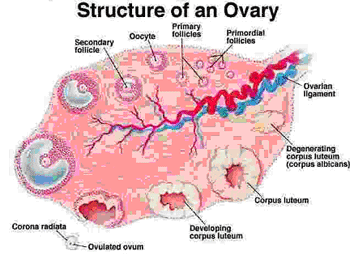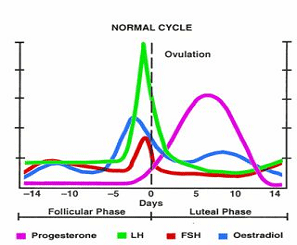Our Reproduction System
Human reproduction is the process for producing new life. It is the process through which genetic material is passed from generation to generation, and maintains the continuation of the human species.
In human reproduction, the new individual results from the coming together of two cells (gametes): an ovum produced by the female, and a sperm produced by the male. The fusing of the two gametes is called fertilisation, and the resulting cell which will grow into the new individual is called a zygote. Each gamete contributes half the genetic material present in the zygote and, hence, in the new individual, half the genetic material is provided by the mother and half by the father.
THE MENSTRUAL CYCLE OF A WOMAN AND CONCEPTION
The reproductive cycle in female humans is known as the menstrual cycle. The cycle is normally 28 days in length but can vary considerably between individuals.
Under the action of FSH (a hormone secreted by the brain) follicles (cyst like structures on the ovary surface) are stimulated to grow (red line on diagram). Each follicle contains an egg, and there may be as many as 6 follicles stimulated to grow. The steroid hormone oestradiol is secreted within the follicle and provides a nurturing environment for the developing egg. (blue line on diagram).
As development proceeds the biggest follicle is able to scavenge all the FSH "starving" the other sister follicles which subsequently die. This leads to the development of a single dominant follicle. This process is complete by Day 10 of the menstrual cycle.
When the dominant follicle has reached maturity (about cycle day 12) it signals the brain to release a burst of the hormone luteinizing hormone (green line on diagram). This hormone starts a process called ovulation that leads to the bursting of the follicle within the next 40-48 hours. On rupture the contents of the follicle including the single mature egg pour into the fallopian tube.

If intercourse occurs within 48 hours of ovulation, then the sperm need to complete the long arduous swim from the vagina, through the uterus and into the fallopian tube. Of the many millions (up to 200 million) that started the journey only several thousand survive to be in the fallopian tube when the egg arrives. One single sperm detects the egg and with its last reserve of energy penetrates the outer egg membrane and is engulfed by the egg cytoplasm. This is the process of fertilisation and within 24 hours cell division occurs. The journey down the Fallopian tube takes 6 days in which time the fertilised egg has become a 130-160 cell structure known as a blastocyst.
The remains of the original ovulated follicle becomes the corpus luteum and secretes a steroid hormone called progesterone (pink line on the diagram). Progesterone helps prepare the uterus for when the blastocyst arrives, 6-8 days after fertilisation.
The blastocyst finds a suitable area, hatches out of it's shell (zona pellucida) and buries itself into the uterine lining. This is the process of implantation. The blastocyst secretes a hormone (chorionic gonadotrophin) that signals the mother that the egg is implanted and is growing. This hormone stimulates the corpus luteum to continue to secrete progesterone.
If the blastocyst does not implant or is not viable this stimulation does not occur. The corpus luteum starts to regress (shrivel and die) by day 21 or 22 and progesterone levels fall (pink line on the diagram). Soon after, the process of menstruation (shedding of the uterine lining) occurs and the cycle starts again. On average only one in five cycles in which fertilisation has occurred will result in implantation and ongoing pregnancy.

Males continuously produce sex hormones and sperm but, in females, the production of sex hormones and the release of an ovum is intermittent, or cyclic, and is known as the menstrual cycle. A period of menstruation, lasting from two to eight days, marks the beginning of a new cycle. The average length of a menstrual cycle is 28 days but it can vary from 21 days to 36 days, or even longer. Ovulation occurs at approximately Day 14 in a 28 day cycle, but occurs earlier in a short cycle and later in longer cycles. (Note that some women menstruate but do not ovulate, i.e. no ovum is released from the ovary.) When an ovum is present, there is a relatively short period of approximately 24 to 48 hours when the woman is fertile. During this fertile period, sperm must be present in the fallopian tube and be able to reach the egg. Only one sperm is required to fertilise the ovum but in order for this to occur there must be a minimum of 40 million sperm per ml in the semen deposited in the woman's vagina. If the ovum is not fertilised, it dies.
In summary, for fertilisation to occur:
- sufficient numbers of sperm must be deposited into the vagina at the appropriate time in the woman's menstrual cycle;
- an ovum has to be released and enter the fallopian tube;
- the fallopian tube must not be blocked, in order for sperm to travel up, and so the fertilised ovum can move down and implant into the lining of the uterus.
Sexual intercourse is an important component of human sexual behaviour. It is usually accompanied by much pleasure for both people, which forms the basis of the strong bond which develops between sexual partners. Sexual intercourse may result in pregnancy and is a component of reproduction.
Enquire from us
Send an enquiry to us now and get a Free Consultation for your visit.